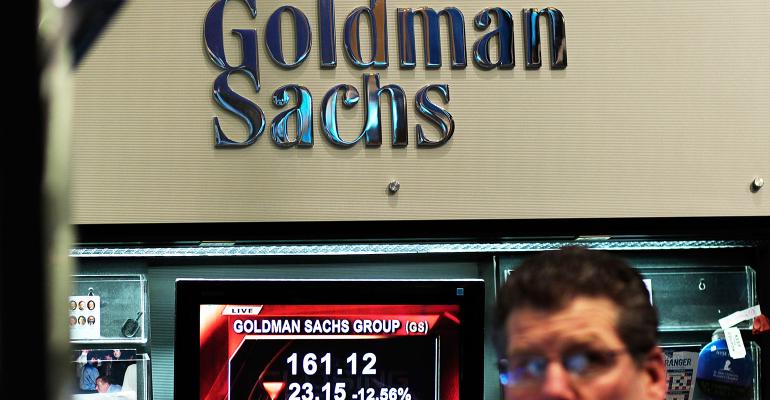(Bloomberg) -- Two of the financial industry’s biggest names -- Goldman Sachs Group Inc. and JPMorgan Chase & Co. -- are in the race for Wall Street supremacy in the $3 trillion global market for exchange-traded funds.
Goldman Sachs won the first leg by pulling in a couple billion dollars in ETF assets in a year. But the competition is just beginning, and JPMorgan has plenty of time to catch up.
“Goldman clearly has a sizable lead,” said Ben Johnson, the Chicago-based director of ETF research for Morningstar Inc. “Goldman did quite a bit of work priming the pump, pre-vetting its strategies with institutional clients. That’s a big piece of it.”
Since Goldman Sachs began offering its quantitative strategy driven ETFs a year ago, the firm has attracted $2.4 billion in assets, making the funds among the most successful product launches in the history of the three-decade-old industry. JPMorgan, which has been selling ETFs for two years, has just above $800 million in assets despite an earlier start and more successful performance record.
Pricing Pressure
In particular, Goldman Sachs has used low prices and its reputation for financial sophistication to attract money, according to analysts. The bank charges 9 basis points on its flagship ETF, the ActiveBeta U.S. Large Cap Equity ETF.
“They have a real panache if you are some RIA in Iowa who has never had a relationship with Goldman at all,” said David Nadig, director of exchange-traded funds at FactSet Research Systems, referring to registered investment advisers. The ability to go to your clients and say “Guess what? We can now get access to Goldman’s quant expertise for the same price as most of the index funds we look at at Vanguard. That’s a really compelling story and story is what works in the RIA community.”
Investors are closely watching the fortunes of the two New York-based banks, each of which have asset-management arms with more than $1 trillion in client money predominantly invested in actively managed accounts. As the firms have begun shifting to more passive ETF strategies, they’re taking on investing giants such as BlackRock Inc., State Street Corp. and Vanguard Group Inc.
As the recent skirmishes show, both Goldman Sachs and JPMorgan see room for more large players in the ETF market.
Chasing Trends
“This is a marathon, not a sprint,” Bob Deutsch, head of JPMorgan’s ETF business, said in an interview, responding to both Goldman Sachs’s early lead and his commitment to the business. “Our expectation is that this will be a big business for us over a long period of time.”
JPMorgan, like Goldman Sachs, is backing its ETFs with a slew of quantitative factors, as the two banks seek to tap into the hot demand for the latest trend: so-called smart-beta strategies. Deutsch, who oversees 22 people, including 10 salesmen, said he’s less concerned about short-term asset growth as long as he’s delivering on the performance front.
The Wall Street firms are pushing into ETFs as they build their asset management units and the steady-as-she-goes revenue they deliver to offset more cyclical investment banking and trading operations. Tim O’Neill and Eric Lane lead Goldman Sachs’s investment-management division, where the ETFs are housed, while Mary Erdoes oversees JPMorgan’s asset-management unit.
Attractive Fees
To do this, the banks are turning to huge distribution arms to sell to wealthy clients, rich families, registered investment advisers, and financial advisers, in addition to institutions. This allows them to keep clients from leaving for cheaper strategies elsewhere, according to FactSet Research’s Nadig.
Paul Boyd, a managing partner at ClearPath Capital Partners, an RIA based in San Francisco, had Goldman Sachs visit his office recently to pitch its ETFs. Boyd, whose firm has resisted the offer for now, says Goldman Sachs is offering a very attractive fee structure.
Goldman Sachs already manages $24 billion in so-called smart beta strategies -- those that weight indexes based on factors such as valuation or growth instead of size or share price -- in other parts of its asset management business, according to Michael Crinieri, who has traded ETFs for a large part of his career and now runs Goldman Sachs’s business with an 11-person team.
“We’re new to the ETF business, but we’re not new to factor-based investing,” said Crinieri, who worked on some of the early ETFs when he was at Morgan Stanley in the 1990s.
Getting Creative
While Goldman Sachs has the upper hand in assets, it lags JPMorgan in performance. Goldman Sachs’s leading U.S. equity ETF has delivered gains of 4.9 percent this year, compared with 8.2 percent for a similar JPMorgan ETF. Goldman Sachs’s international equity and emerging market equities funds have also lagged behind JPMorgan’s.
Now, the two firms are preparing to get creative as they fight to expand in the space. JPMorgan started a hedge fund-focused ETF last week and Goldman Sachs plans to follow suit with its own product catering to that area. JPMorgan also dove into fixed-income ETFs for the first time with a high-yield fund, while Goldman Sachs began offering a short-term Treasury fund and is mulling other forays.
Both firms say that this race is just getting started, meaning it’s far too early to call a winner.
“We’re talking about a very small period of time,” Crinieri said. “There isn’t a long period of time where you can make any fair comparisons.”
To contact the reporters on this story: Dakin Campbell in New York at [email protected] ;Sridhar Natarajan in New York at [email protected] To contact the editors responsible for this story: Peter Eichenbaum at [email protected] ;Nabila Ahmed at [email protected] Eric J. Weiner, Steve Dickson





